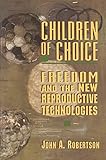Children of Choice : Freedom and the New Reproductive Technologies / John A. Robertson.
Material type: TextPublisher: Princeton, NJ : Princeton University Press, [2021]Copyright date: ©1994Description: 1 online resource (291 p.)Content type:
TextPublisher: Princeton, NJ : Princeton University Press, [2021]Copyright date: ©1994Description: 1 online resource (291 p.)Content type: - 9781400821204
- Abortion -- Moral and ethical aspects
- Abortion
- Bioethics
- Contraception Behavior
- Contraception -- Moral and ethical aspects
- Human reproductive technology -- Moral and ethical aspects
- Reproductive technology
- SOCIAL SCIENCE / Women's Studies
- Adoption
- Alpha fetal protein
- Ambivalence
- American Fertility Society
- Amniocentesis
- Assisted reproduction
- Baltimore school system
- Bladerunner scenario
- Cesarean section
- Chorion villus sampling
- Contraception
- Copeland, Rhonda
- Cystic fibrosis
- Duchenne’s muscular dystrophy
- Eisenstadt v. Baird
- Enhancement of offspring
- Fetal surgery
- Freedom of Choice Act
- Gestational surrogacy
- Griswold v. Connecticut
- Human Genome Initiative
- In utero interventions
- Infertility
- Kingdom, Elizabeth
- Marshall, Thurgood
- National Institutes of Health
- Norplant
- Ontario Law Reform Commission
- Overpopulation
- Parkinson’s disease
- Phenylketonuria
- Philadelphia Inquirer
- Probation
- RU486
- Radin, Margaret
- Reproductive revolution
- Rothman, Barbara Katz
- Shakespeare, William
- Sickle cell anemia
- Sterilization
- Sullivan, Louis
- Syngamy
- Teenagers
- Thirteenth Amendment
- Undue burden test
- Vatican
- Viability
- Victoria (Australia)
- Warnock Committee
- Wyden, Ron
- Wyeth-Atherst
- 176 23
- RG133.5
- online - DeGruyter
| Item type | Current library | Call number | URL | Status | Notes | Barcode | |
|---|---|---|---|---|---|---|---|
 eBook
eBook
|
Biblioteca "Angelicum" Pont. Univ. S.Tommaso d'Aquino Nuvola online | online - DeGruyter (Browse shelf(Opens below)) | Online access | Not for loan (Accesso limitato) | Accesso per gli utenti autorizzati / Access for authorized users | (dgr)9781400821204 |
Frontmatter -- Contents -- Preface -- CHAPTER 1 Introduction TECHNOLOGY, LIBERTY, AND THE REPRODUCTIVE REVOLUTION -- CHAPTER 2 The Presumptive Primacy of Procreative Liberty -- CHAPTER 3 Abortion, Contragestion, and the Resuscitation of Roe v. Wade -- CHAPTER 4 Norplant, Forced Contraception, and Irresponsible Reproduction -- CHAPTER 5 IVF, Infertility, and the Status of Embryos -- CHAPTER 6 Collaborative Reproduction DONORS AND SURROGATES -- CHAPTER 7 Selection and Shaping of Offspring Characteristics GENETIC SCREENING AND MANIPULATION -- CHAPTER 8 Preventing Prenatal Harm to Offspring -- CHAPTER 9 Farming the Uterus NONREPRODUCTIVE USES OF REPRODUCTIVE CAPACITY -- CHAPTER 10 Class, Feminist, and Communitarian Critiques of Procreative Liberty -- Notes -- Index
restricted access online access with authorization star
http://purl.org/coar/access_right/c_16ec
Cloning, genetic screening, embryo freezing, in vitro fertilization, Norplant, RU486--these are the technologies revolutionizing our reproductive landscape. Through the lens of procreative liberty--meaning both the freedom to decide whether or not to have children as well as the freedom to control one's reproductive capacity--John Robertson, a leading legal bioethicist, analyzes the ethical, legal, and social controversies surrounding each major technology and opens up a multitude of fascinating questions: Do frozen embryos have the right to be born? Should parents be allowed to select offspring traits? May a government force welfare recipients to take contraceptives? Robertson's arguments examine the broad range of consequences of each reproductive technology and offers a timely, multifaceted analysis of the competing interests at stake for patients, couples, doctors, policymakers, lawyers, and ethicists.
Mode of access: Internet via World Wide Web.
In English.
Description based on online resource; title from PDF title page (publisher's Web site, viewed 01. Dez 2022)


